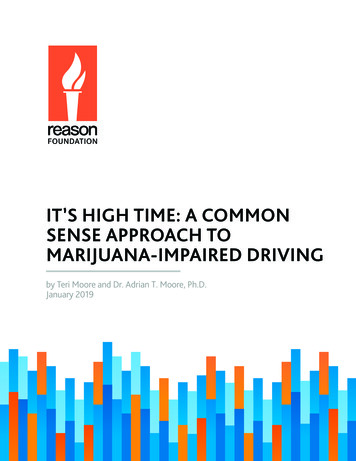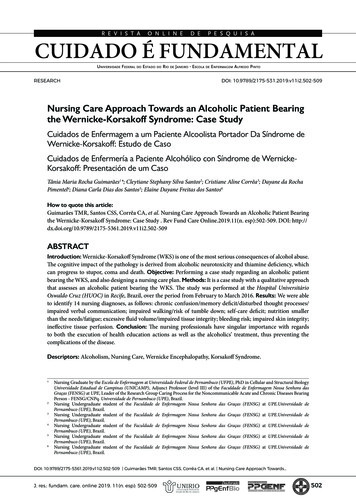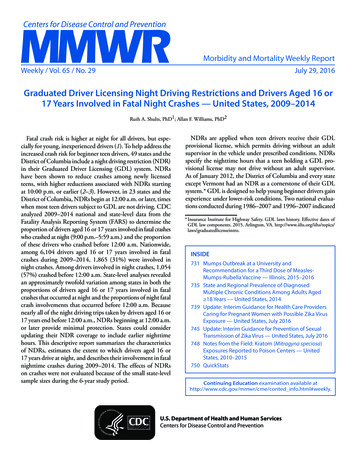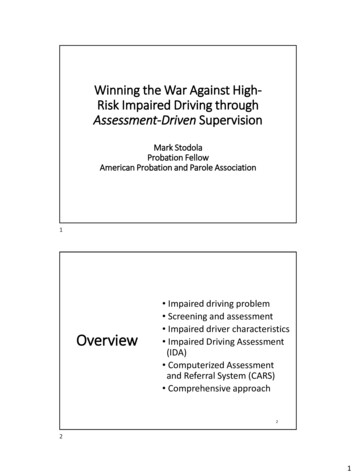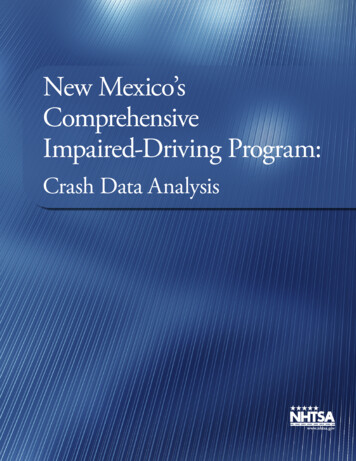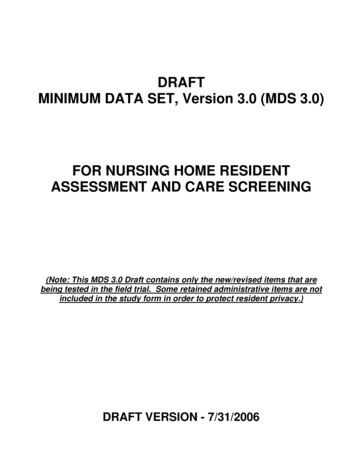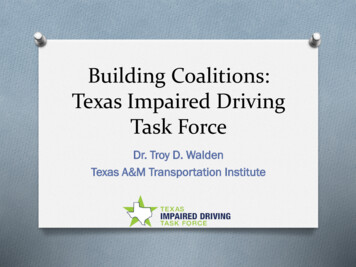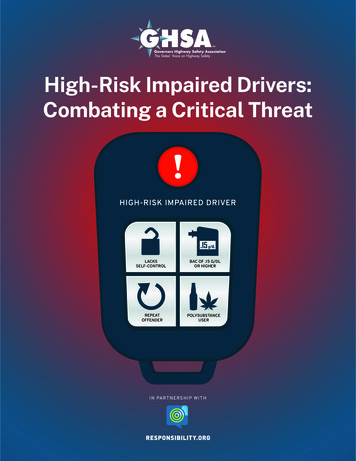
Transcription
High-Risk Impaired Drivers:Combating a Critical ThreatLACKSSELF-CONTROLREPEATOFFENDERBAC OF .15 G/DLOR HIGHERPOLYSUBSTANCEUSERI N PART N E R S HI P WI T H
Table of ContentsIntroduction3Why Focus on the High-Risk Impaired Driver?6Taking a Comprehensive and Holistic Approach8Screening and Assessment8Law Enforcement & Toxicology10Prosecution and Adjudication13Treatment and Supervision15Data Collection19Individualized Justice in Action21DUI Monitoring Court—A County Model23Statewide Impaired Driving Management—A State Model25Moving from a Conviction to Individualized Justice Approach27State DUI Task Forces29Local DUI Task Forces30A Snapshot of Proven, Promising and Best Practices32DUI Treatment Courts32Alcohol & Drug Monitoring34Public Outreach & Education36Training & Continuing Education39High Visibility Enforcement42Drug Evaluation Classification Program45Prosecution46Probation47Data Sharing & Electronic Warrants48Phlebotomy50Toxicology51Screening & Assessment52Final Thoughts54References56Acronym Key59AcknowledgementsPam Shadel Fischer, Principal, Pam Fischer Consulting, researched and wrote the publication.Russ Martin, Director of Policy and Government Relations, GHSA, and Dr. Leanna Depue, Depue Consultingand retired Missouri Highway Safety Office Director, reviewed and edited the publication.Kara Macek, Senior Director of Communications and Program, GHSA, oversaw the publication production.Creative by Brad Amburn.Funding was provided by the Foundation for Advancing Alcohol Responsibility (Responsibility.org).Published December 2019.PAG E 2 o f 6 1
IntroductionAlcohol-impaired fatalities accounted for 29 percent of all U.S. motor vehicle deathsin 2018, the lowest percentage since 1982 when the National Highway Traffic SafetyAdministration (NHTSA) began reporting alcohol data. This was sparked by a 3.6percent decrease in alcohol-impaired driving fatalities from 2017 to 2018 (NationalCenter for Statistics & Analysis [NCSA], 2019). Thanks to the efforts of MothersAgainst Drunk Driving (MADD), NHTSA in partnership with State Highway SafetyOffices (SHSOs) and state and local law enforcement, as well as Responsibility.org,Students Against Destructive Decisions, the National Safety Council, and many otherorganizations, the nation’s roadways are become safer.National Alcohol-Impaired Driving Fatalities, 2017-2018Total fatalities: 37,4732017–2.4%Alcohol-impaired fatalities: 10,908Total fatalities: 36,5602018–3.6%Alcohol-impaired fatalities: ,000In 2018, an average of one alcohol-impaired driving fatalityoccurred every 50 minutes, which translates to 29 deaths each day.Even with this progress, impaired driving remains a major highway safety problemnationwide. In 2018, an average of one alcohol-impaired driving fatality occurredevery 50 minutes, which translates to 29 deaths each day. This may seem difficult tocomprehend given the stigma associated with drunk driving, but 10,511 people losttheir lives in motor vehicle crashes involving at least one driver with a blood alcoholconcentration (BAC) of .08 g/dL or higher. Even more startling is that these deathsaccounted for nearly one third of all people killed on our nation’s roadways (NCSA,2019). These, however, are only the alcohol-impaired driving motor vehicle fatalities.There are more than 111 million self-reported episodes of alcohol-impaired drivingamong U.S adults annually, equating to 300,000 incidents a day (Centers for DiseaseControl [CDC] and Prevention, 2019).Clearly, when it comes to drunk driving there is a disconnect between drivers’attitudes and their behavior resulting in a significant danger on the road. Accordingto the AAA Foundation for Traffic Safety’s 2018 Traffic Safety Culture Index (2019),PAG E 3 o f 6 1
more than 95 percent of drivers indicated that driving after drinking enough alcoholto be over the legal limit is very or extremely dangerous. But approximately 11 percentof those same motorists admitted to engaging in this dangerous behavior in thepast month. National Safety Council (NSC) research mirrors the AAA findings, buteven more troubling is that nearly half of the motorists who said they drove over thelegal limit, felt they were unsafe behind the wheel and 47 percent said they almostcrashed (2017).Impaired driving, however, is not solely alcohol related. Drugs—both legal (includingprescription and over-the-counter medications as well as cannabis in some states)and illegal—are playing an increasingly more prevalent and dangerous role in motorvehicle crashes. Between 2006 and 2016, the rate of fatally injured drivers (with knowntest results) that tested positive for drugs increased from 28 percent to 44 percent(Fatality Analysis Reporting System [FARS] as cited in Hedlund, 2018). The mostcommonly ingested substances included stimulants (e.g., cocaine, methamphetamine),depressants (e.g., Xanax, Valium), narcotic analgesics (opioids, heroin), dissociativeanesthetics (e.g., PCP, ketamine), cannabis, and a combination of these and other drugs(Sobriety Testing Resource Center and Drug Recognition Expert [DRE] EvaluationsSystem as cited in International Association of Chiefs of Police [IACP], 2019).Nationwide in 2016, 50.5 percent of fatally injured, drug-positive drivershad two or more drugs in their system and 40.7 percent were found tohave alcohol in their system.Combining substances, even at low levels, can significantly increase crash risk. Thisis referred to as polysubstance use and despite the danger of consuming alcohol anddrugs or multiple drugs, the behavior is on the rise. For example, Denver, Colorado(the first state to legalize recreational cannabis), experienced a 300 percent jumpin polysubstance-impaired driving cases from 2013 to 2016. Alcohol and THC(tetrahydrocannabinol), the main psychoactive compound in cannabis that givesthe sensation of being high, were the most common combination (Ma, 2019). InWashington State, drivers convicted of impaired driving were two and five times morelikely to test positive for polysubstance use than alcohol and THC-only, respectively(Grondel, Hoff & Doane, 2018). Nationwide in 2016, 50.5 percent of fatally injured,drug-positive drivers had two or more drugs in their system and 40.7 percent werefound to have alcohol in their system (FARS as cited in Hedlund, 2018).All motorists who drive impaired—regardless of the substance—pose a hazard tothemselves and others but the greater the level of impairment the higher the crashrisk. While a BAC of .08 g/dL is the legal limit in all states (the exception is Utah, wherethe legal limit is .05 g/dL), 66 percent of the alcohol-positive drivers involved in fatalcrashes in 2018 had BAC levels at or above .15 g/dL, with the most frequent being .16g/dL (NCSA, 2019). Looking at the states, the percentage of fatalities involving a driverPAG E 4 o f 6 1
DUI or DWI?Driving under the influence (DUI) is the most commonly used abbreviation to denote animpaired driving offense. In this publication, DUI is the most frequently used term to describealcohol- and drug-impaired driving. Other abbreviations, such as driving while intoxicated(DWI), operating under the influence (OUI) and operating while impaired (OWI) may be usedwhen discussing specific state laws or programs.with a BAC of .15 g/dL or higher ranged from a high of 31 percent (Montana) to a lowof 12 percent (Kentucky and West Virginia), compared to the national average of 19percent. Perhaps most alarming is that these high-BAC impaired drivers are involved inmore than 60 percent of the alcohol-impaired driving deaths each year (NCSA, 2019).Drivers with BACs of .08 g/dL or higher, who were involved in fatal crashes, were also4.5 times more likely to have prior convictions for driving under the influence (DUI)than drivers with no alcohol (9 and 2 percent, respectively). These repeat offenderscause about one-third of all impaired driving deaths annually, a statistic that hasremained relatively unchanged for years (NCSA, 2018). That combined with a 16percent increase over the past 10 years in the number of alcohol-impaired driverskilled in crashes who also tested positive for drugs (Nordstrom, 2019), gives an entirelynew meaning to the term high-risk impaired driver or HRID.This publication focuses on the challenges and opportunities associated with thehigh-risk impaired driver—a person who lacks the restraint or self-control to resistdriving impaired (Kean, Maxim & Teevan as cited in Lowe, 2014). A high-risk impaireddriver is likely to drive with a BAC of .15 g/dL or higher—or after consuming drugs ora combination of alcohol and drugs—and to do so repeatedly as evidenced by havingmore than one DUI arrest. Whatever the impairing substance, the high-risk impairedDefining the High-Risk Impaired Driver (HRID)Lacks the restraintor self-control toresist drivingimpairedBlood AlcoholConcentration (BAC)of .15 g/dL or higherRepeatoffenderPolysubstanceuserPAG E 5 o f 6 1
driver is highly resistant to changing his/her behavior despite sanctions, treatmentor education and poses an elevated crash risk (Holmes & Dalbec, 2015). To reducerecidivism, stop the revolving door and save lives, more must be done to identify andaddress the high-risk impaired driver.Why Focus on the High-Risk Impaired Driver?High-BAC, repeat offender, polysubstance user what makes today’s high-riskimpaired drivers (HRIDs) particularly challenging is that we cannot eliminate thepublic safety threat by only punishing them for each driving incident. Many of theseoffenders have both a substance use disorder (SUD) and a mental health disorder(Shaffer et al., 2007). DUI offenders who suffer from a psychiatric disorder otherthan a SUD are more likely to reoffend, and reoffend more quickly (Nelson, 2016).Unfortunately, impaired driver mental health issues are often missed so they gountreated. Loopholes in the criminal justice system, coupled with a lack of awarenessof mental health issues among some working to address impaired driving, also meanthat these offenders often go unmonitored, fail to comply with their sentences andconditions of supervision and do not receive adequate treatment that produces thelong-term behavior change necessary to prevent recidivism. In many cases, they arenot held accountable nor do they face consequences for non-compliance resulting ina dangerous cycle that puts all road users at risk.Many HRIDs have a substance use disorder and/or a mental health disorder.That is why it is critical that this segment of the DUI population, which isdisproportionately responsible for fatalities on our roadways, be targeted throughpolicy, interventions and funding. The resources necessary to do this are significant,but the return on investment—a reduction in lives lost and societal costs—simplycannot be ignored.Consider the following, in 2010 (the most recent year for which cost data is available)the economic cost of motor vehicle crashes was 242 billion, with drunk drivingaccounting for 44 billion of that price tag. These figures represent tangible costssuch as lost productivity, workplace losses, legal and medical expenses, insurance,emergency response, property damage, and congestion. But in cases of serious injuryor death, they do not begin to capture the impact on lost quality of life, which equatesto 836 billion for all crashes. Impaired drivers accounted for 201.1 billion of that 836 billion, with HRIDs responsible for the largest share (NCSA, 2018). For thosethat lost a loved one and/or are caring for a family member with an incapacitatinginjury resulting from a crash caused by a HRID, the impact is devastating.PAG E 6 o f 6 1
In 2010, the economic cost of motor vehicle crashes was 242 billion,with drunk driving accounting for 44 billion of that price tag.What can State Highway Safety Offices (SHSOs) and their partners do to effectivelyaddress the HRID problem? This publication will explore the following key topics:»Why adoption of a comprehensive and holistic approach is needed and what itlooks like;»How state and local task forces, which SHSOs often administer and/orparticipate on, can be tapped to identify the gaps in the system and thenecessary resources, expand existing initiatives that are working, and improveimplementation for better accountability and behavior change; and»What evaluated programs, best practices and proven or promising approachesSHSOs are currently funding or could fund that merit consideration, and theimportance of funding programs and initiatives that are evaluated to determinetheir impact on reducing recidivism.Information for this publication was culled from a variety of online resources, printedmaterials, one-on-one interviews, and discussion with members of an expert workinggroup composed of representatives from law enforcement, prosecution, the judiciary,driver licensing, toxicology, probation, treatment and prevention, as well as SHSOs,NHTSA, the National Conference of State Legislatures, the National GovernorsAssociation, Responsibility.org, and Governors Highway Safety Association (GHSA).Funding for this publication was provided by Responsibility.org, which first shined a spotlight on the hardcore drunkdriver two decades ago with the release of its comprehensiveprogram to address hardcore drunk driving. Today, thispopulation is now referred to as high-risk impaired drivers andthey remain a critical threat on our nation’s roadways. To refocus attention on thisproblem, Responsibility.org has developed a web-based repository of promising andevidence-based practices from across the country, some of which are included in thispublication, along with federal and state checklists for policymakers and advocates.In addition, an interactive online roadmap that illustrates the DUI process and theroutes an individual can take to get to the preferred destination—long-term behaviorchange—is in development. These Responsibility.org resources and this GHSAdocument are intended to be complementary pieces. The SHSOs and their partnersare encouraged to use both as they work to identify and implement solutions toeffectively address the HRID. To assist in this effort, Responsibility.org will work withGHSA to provide grants to help SHSO’s implement recommendations and initiativesdiscussed in this publication.PAG E 7 o f 6 1
Taking a Comprehensive and Holistic ApproachHigh-risk impaired driving is a complex problem. The typical legislative responseis to levy heavy fines and incarcerate the HRID. This “make ‘em pay and lock ‘emup” approach may get these offenders off the street, but punishment aimed at theimmediate behavior rather than the cause and delivered in a vacuum is unlikelyto reduce recidivism or lead to long-term behavior change. At the same time,most SHSOs address impaired driving by awarding grants principally to help lawenforcement detect, arrest and convict violators. This conviction-centered approach,or what some refer to as cookie-cutter justice, de-emphasizes the unique, long-termneeds of the HRID and typically is not effective in deterring them from re-offending.Cookie-cutter justice focuses on detecting, arresting, and convicting violatorsand de-emphasizes the unique needs of the HRID.Individualized justice is a multidisciplinary effort to identify the root causeof an offender’s behavior, determine the appropriate sanctions, and preventrecidivism.What is more effective, according to criminal justice experts, is individualizedjustice. This comprehensive and holistic approach involves practitioners from manydisciplines collaborating to identify the root cause of the offender’s behavior andthen determine what sanctions should be administered. States and communitiesadopting an individualized justice approach create systems that incorporatemultidisciplinary input from law enforcement, prosecution, the defense, the courts,probation and parole, treatment, and driver licensing. To reduce recidivism, theteam works together to ensure punishment is combined with long-term behaviormanagement. This may include alcohol/drug monitoring technologies such asignition interlock devices, transdermal alcohol testing and other systems; intensivesupervision that holds the offender accountable for any violation of the terms of his/her sentence; and treatment and aftercare that takes into account the offender’slearning style, gender, culture, and motivation. This approach is not coddling; lack ofprogram compliance or impaired driving recidivism prompts consequences, whichmay include incarceration.Screening and AssessmentScreening and assessment are the centerpiece of the individualized justiceapproach. These are clinical evaluation tools used to help identify the DUI offender’srisk of engaging in future impaired driving events and to determine the mosteffective community supervision that will reduce that risk (Lowe, 2014). Screeningand assessment are critical because DUI offenders are a distinct population withinthe criminal justice system. Prior DUIs and other traffic infractions may be commonPAG E 8 o f 6 1
among HRIDs, but they often lack a history of otheroffenses. This coupled with the presence of other prosocial and protective factors, such as higher levelsof education and employment and strong communityties, often leads to these offenders being classified aslow risk, despite having a heightened risk of causingdeath or serious injury. In addition, HRIDs often haveunique needs and are resistant to change because oflimited insight into their behavior.Screening andAssessment are clinicalevaluation tools usedto help identify the DUIoffender’s risk of engagingin future impaired drivingevents and to determinethe most effectivecommunity supervisionthat will reduce that risk.Many states require motorists convicted of DUI toundergo screening and assessment, but there is agreement among experts that itdoes not always happen or happen early enough. Ideally, screening and assessmentshould occur during the pre-trial phase, so the results along with the police report,prior offense history, and previous or current probation and other significantinformation can be used to inform sentencing decisions, case management plans,supervision levels, and treatment. But assessments can be repeated at multiple timesduring the offender’s involvement in the criminal justice system to identify progressand make plan adjustments as needed (Nannini, 2018).Screening is the first step in the process of determining if the offender should bereferred for treatment as it is used to identify if s/he has a substance abuse and/or mental health problem. Typically administered by a criminal justice or treatmentprofessional, screening involves the HRID answering a brief series of questionsthat are linked to a risk scale. This is an efficient and effective way to target limitedresources by separating offenders into different categories (i.e., SUD, low or highrisk, anti-social behavior) so they receive the appropriate level of supervision and/or treatment. It can also serve as a brief intervention since it requires the offenderto begin thinking about his/her substance use patterns and whether they areproblematic (Nannini, 2018). (Numerous screening tools are available; consult theSubstance Abuse and Mental Health Association website for guidance.)Determining the offender’s risk level is critical. Placing someone identified as low-riskwith high-risk offenders can lead to poor outcomes and result in the former beingLOWHIGHDetermining risk level is critical. Placing someone identified as low-risk with high-riskoffenders can lead to poor outcomes and result in the former being influenced by thelatter, who are at a higher-risk of recidivating.PAG E 9 o f 6 1
influenced by the latter, who are at a higher-risk of recidivating. Providing intensivesupervision and treatment for an offender who does not need it, can lead to negativeoutcomes as well. High-risk offenders, on the other hand, need intensive servicesincluding supervision and treatment. Unlike their low-risk counterparts, they are lesslikely to self-correct and often have more criminogenic needs that must be addressed(Nannini, 2018).Following screening, assessment is administered to those offenders who showsigns of substance or mental health issues. This is more time-intensive thanscreening as it explores individual issues in-depth to evaluate not only the presenceof an alcohol and/or drug problem, but its extent and severity. Assessments aretypically administered by a trained professional. There are numerous assessmentinstruments such as the Risk and Needs (RANT) and Alcohol Severity Index (ASI).Currently four (two are discussed in more detail on pages 24 and 53) are validatedfor use with DUI offenders: DUI-RANT, a modified version of the RANT, that is ascreener/triage tool; Adult Substance Use and Driving Survey Revised (ASUDS-R)and its predecessor ASUDS; Computerized Assessment and Referral System (CARS)developed by Cambridge Health Alliance, a teaching affiliate of Harvard MedicalSchool, with funding from Responsibility.org; and the Impaired Driving Assessment(IDA) developed by the American Probation and Parole Association (APPA) incollaboration with NHTSA (Wanberg & Timken, 2007; Ferris, 2007; White & Syrcle,2008; Nannini, 2018).Law Enforcement & ToxicologyThe individualized justice approach does not meanSHSOs should stop awarding grants to law enforcement.Rather, SHSOs should take a more strategic approachto addressing impaired driving. Law enforcement grantsshould be directed to enforcement tactics that are themost effective in detecting impaired drivers such ascheckpoints, saturation patrols and special DUI strike ortask forces (see pages 27–32 for more information on thelatter), as well as training that will help officers quicklyand effectively identify the impairing substance(s) beyondalcohol. Drug-impaired driving is a growing road safety threat requiring new tools,techniques and technology. In addition, the individualized justice approach calls fora greater focus on individual circumstances, which is often lacking in drug-impairedand polysubstance use cases due to limitations in some current enforcementpractices. Failure to identify drug use has implications for sentencing, supervisionand treatment.As the data clearly show, many offenders use multiple substances. If their drug useis not captured at the time of arrest, there is a high probability these offenders willcontinue to use because they will be subject only to alcohol monitoring. This lack ofPAG E 1 0 o f 6 1
accountability means the likelihood of behavior change is low and, as a result, theseoffenders will continue to pose a threat and likely recidivate. However, there are fourpromising ways to mitigate this:Police drug recognition trainingEvery state is investing in more Standardized Field Sobriety Testing (SFST),Advanced Roadside Impaired Driving Enforcement (ARIDE) and DrugRecognition Expert (DRE) training. ARIDE provides officers with generalknowledge of drug impairment, while DREs apply a standardized, systematic12-step protocol that leverages a combination of physiological, behavioral, andtoxicological evidence to evaluate impaired driving suspects.These training programs are currently the most effective line of defense in ahighway safety environment without scientifically validated per se limits forTHC and other drugs. It is also important to note that field sobriety tests aresensitive for THC and both DREs and non-DREs can determine impairmentfrom the compound. However, THC concentrations cannot be correlated tospecific impairment (Harmon, 2019a).Increased testing for impairing drugsUnder the conviction-focused approach introduced earlier, an officerconfronted with a suspected impaired driver conducts the SFST and/orpreliminary breath test (PBT) at roadside. (In some jurisdictions, the officermay also perform ARIDE or DRE testing or call in a DRE.) If the motorist failspreliminary screening, s/he is arrested, a breath sample is collected, andpossibly blood and/or urine, for evidentiary testing by a toxicology laboratory.However, in most jurisdictions if the BAC exceeds a certain concentrationsuch as at or over the per se limit, drug testing is not performed. There may beexceptions such as a crash involving a serious injury or fatality or a DRE findingof potential drug impairment. (Concerning the former, there are still gaps inMaking the Case for Drug ScreeningsIn Orange County, CA, the crime lab is screening all blood obtained in DUI arrests for drugssuch as cannabis, cocaine, heroin, and prescription medications. The effort is paying off asimpairing drugs were detected in more than one-third of BAC samples of .08 g/dL or greaterin 2018 (Harmon, 2019). Meanwhile, researchers at Virginia Tech are partnering with U.S.toxicology labs to examine impaired driving cases where motorists were at or above thealcohol per se limit resulting in no further testing for drugs. The goal is to show the value oftesting beyond the BAC cut off as well as to identify the low hanging fruit when it comes towhat drugs to test for. For states, identifying the prevalence of drugs can better inform policydecisions aimed at impaired drivers particularly those who are high-risk.PAG E 1 1 o f 6 1
the data. In 2017, 62 percent of drivers killed in the U.S. were tested for alcohol,while only 24 percent of drivers who survived fatal crashes were tested [NCSA,2019].) Experts agree, however, that testing only what is necessary to get theconviction fails to uncover the motorist’s substance use problem, which iscentral to the individualized justice approach, and undermines impaired drivingprevention. And, it merits pointing out that DUI is “the only crime where theinvestigation ends after a minimal amount of evidence is obtained” (S. Talpins,personal conversation, 2019).Leveraging new drug screening technologiesResearch confirms that laboratory testing of DUI suspects for drugs is notcommon and that it is influenced by the confirmation of alcohol intoxication(Arnold & Scopatz, 2016). Cost is also a factor, as blood tests typically average 25-35 compared to drug panels that can range from 100-300 and more.One potential solution is for law enforcement to use oral fluid tests as anonsite screener to identify the presence of drugs roadside or in a police stationto help establish probable cause. (The roadside devices cost approximately 4,000, with single-use cartridges costing 17-20 each.) These tests are quickand easy to use, minimally invasive and painless, and because the sample iscollected close to the time the driver was operating a vehicle, they are a morereliable indicator of the presence of drugs at the time of the stop. Oral fluidtests are comparable to preliminary breath tests; they cannot conclusivelydetermine a driver’s level of impairment, but they can be used to collectevidence as part of a broader impaired driving investigation (Flannigan, Talpins& Moore, 2017).Admissibility of Oral Fluid TestingOral fluid evidence was used to convict a California motorist in 2016.A Bakersfield police officer, participating in an SHSO-funded pilot,administered an oral fluid test and a breathalyzer test to a motorist at thescene of a fatal crash. At the police station, the motorist was breathalyzed asecond time and blood drawn. The oral swab revealed the motorist had usedmethamphetamine that was confirmed by the blood test (cannabis was alsodetected by the latter). The motorist’s BAC was .03 g/dL (Douglas, 2016).Expediting impaired driving investigationsThe longer an impaired driving investigation takes at the roadside, the greaterthe decline in measurable levels of impairing substances in an offender’s body.By the time a blood draw occurs, critical evidence could be lost resulting in thedriver not being identified as an HRID. To address this, some law enforcementagencies are training police officers as phlebotomists to reduce the timebetween arrest and the collection of chemical evidence. To aid in this effort,NHTSA developed a Law Enforcement Phlebotomy Toolkit, that draws fromPAG E 1 2 o f 6 1
existing, successful law enforcement phlebotomy programs. (Best practices areidentified on page 50.)One longtime law enforcement official called certified phlebotomist officersa potential “game changer” when it comes to combatting drugged driving (S.Casstevens, personal conversation, May 2019). Law enforcement agenciesreduce costs because they do not need to pay phlebotomists and hospitalsfor blood draws. Law enforcement phlebotomy programs also simplify theevidentiary chain of custody since fewer people are handling the blood sample(NHTSA, 2019).Technology is also being developed and deployed to help officers obtainelectronic search warrants (e-warrants) in a matter of minutes, day or night, tospeed up non-voluntary blood draws. Well-established and diverse e-warrantsystems are discussed in A Guide to Implementing Electronic Warrants,developed by the Justice Management Institute. (See pages 48–50 forexamples of state e-warrant programs.)Prosecution and AdjudicationIn an individualized justice approach, the prosecutor and defense attorney workcollaboratively rather than as adversaries to ensure the public and the HRID’s bestinterests are served. That means they focus on helping the HRID get the treatmentand care s/he needs to address the root problem(s) causing the risky behavior andlessen the likelihood of re-offending. This runs contrary to the traditional goal ofthe prosecutor and the defense attorney, where the former strives to convict theoffender to the fullest extent of the law, while the latter seeks to mitigate the impactof the offense, so the offender can get back on the road. For the former to happen,both need to be at the table to review, in concert with the other disciplines, thescreening and assessment findings, so more informed decisions are made that resultin better outcomes for the pub
driving impaired (Kean, Maxim & Teevan as cited in Lowe, 2014). A high-risk impaired driver is likely to drive with a BAC of .15 g/dL or higher—or after consuming drugs or a combination of alcohol and drugs—and to do so repeatedly as evidenced by having more than one DUI arrest. Whatever the impairing substance, the high-risk impaired
